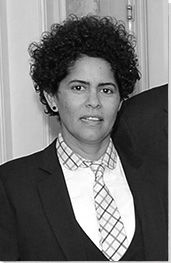Summary of Julie Mehretu
Contemporary artist Julie Mehretu's extraordinarily grand scale works examine our communal connections with place and identity through abstracted landscapes rife with complexity. Her work considers the sociopolitical history of specific locations via multi-layered and wildly chaotic mark-making alluding to architecture, geography, topography, autobiography, and iconography. These investigations culminate in radically innovative self-portraits of myriad spaces alongside our human intrusions into, and engagement with them.
Accomplishments
- Mehretu's impetus to explore our associations with place stems from her need to process real world events. By creating her own investigative space on the canvas where her feelings can play themselves out through art, she invites viewers to think about the past, present and future of various locations in ephemeral, cultural, emotional, and physical ways.
- The artist's work is noted for its signature visual language of dots, lines, symbols, and shapes indicative of the type of visual experience one has when looking down at the world from an aerial perspective. She coins these amalgamations "communities" and they inform her signature visual language in much the same way as a cartographer relies on map-making marks.
- Mehretu's abstracted "maps" bring geography, culture, history, and politics together in an entirely new way, allowing for distinct visual autobiographies of any given location. Regardless of any particular identifiers, her artistic terrains evoke a hybrid of past and present that is perpetually in flux, creatively conveying our contemporary world as one of constant dynamism, change, erasure, and renewal.
- The intricate nature of Mehretu's work involves hours of researching source material relevant to place including architectural imagery, maps, charts, historical and contemporary logos and signage, and historical photographs. This process is further lengthened by the act of physically making the large scale work, built up of a significant number of layers.
The Life of Julie Mehretu
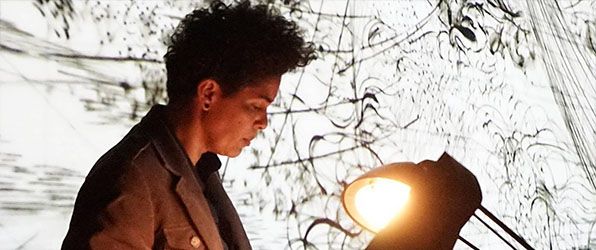
Artist Daniel Gerwin has described Mehretu’s work as “awe-inspiring, an informational sublime, a 21st-century twist on the artistic tradition.”
Important Art by Julie Mehretu
Empirical Construction, Istanbul
At the time of its making, Empirical Construction, Istanbul was one of Mehretu's largest works, at 10 x 15 feet, and the only one based on a single city. The painting reads as an explosion from a central point, which can be identified as a domed building, likely the Hagia Sophia - a former Eastern Orthodox church, later an Ottoman imperial mosque, and now a museum. The Hagia Sophia perhaps epitomizes the coming together of cultures: the capacity of Istanbul's architecture to reflect the historic influences of the Roman, Byzantine, and Ottoman empires, as well as its unique position bridging Europe and Asia.
Against this background of its ancient past, the modernity and energy of the city comes across in bright colors and graphic shapes, arranged in a whirlwind. The whole is typical of Mehretu's interest in the transforming city. Some critics, however, read the dynamism in which the city is depicted, almost as if engulfed by a tornado, as a warning. According to MoMA, "The mad profusion of chaotic information provides alarming signs of an out-of-control city in a state of emergency."
The painting is made up of layers, as is again typical of Mehretu's work. The first comprises detailed architectural drawings of the Old City of Istanbul. The second consists of abstract marks made with ink, and then a top layer of brightly colored shapes and lines reminiscent of flags and corporate logos. Identifiable motifs include the star and crescent and Arabic calligraphy. For artist and writer Julia Clift, the combination of these layers describes both the human and the urban condition, upon which various forces (such as our emotions, religion, and the influence of corporations) impact even as they work within, an organized and intricate structure.
Elements from Empirical Construction, Istanbul, such as the flag motifs, went on to inform Mehretu's Stadia series of the following year. The series explores ideas of nationalism and public spectacle, and is visually similar to Empirical Construction, Istanbul.
Acrylic and ink on canvas - The Museum of Modern Art, New York City
Grey Area
Grey Area is a series of seven, predominantly monochrome, large-scale paintings, commissioned by the Deutsche Guggenheim and exhibited in New York in 2010. The paintings explore Mehretu's interest in the generation and destruction of the urban landscape, in which can be found the evidence and traces of lived history. The paintings were inspired to a large extent by Berlin, the city in which Mehretu created the works while undertaking a six-month residency. However, the artist also references other cities in a state of transformation, such as those affected by the wars in Iraq and Afghanistan.
The paintings in Grey Area have an under-layer of detailed drawing that demands the viewer's close attention if it is to be recognized and appreciated. This is more dominant in Grey Area than in other works by the artist, which are more colorful and have more emphasis on abstract geometric shapes. Accordingly, there was a large amount of precise architectural drawing involved in the making of the paintings.
The source material for these drawings includes the facades of nineteenth-century German buildings that were destroyed during World War II, a photograph of the bombed United Nations headquarters in Baghdad, an aerial image of the World Trade Center site after the 9/11 attacks, and dilapidated buildings near Mehretu's childhood home. On top of the drawings, Mehretu has added marks in ink and acrylic, but in places, these have been erased.
According to the Guggenheim, the Grey Area paintings "meditate on the idea of the modern ruin." The art historian Sue Scott has said of the series, "In these somber, simplified tonal paintings ... one gets the sense of buildings in the process of disappearing, much like the history of the city she was depicting." As such, there is a connection between Mehretu's artistic process of adding and taking away, and the impact of conflict on the urban environment, whereby cultural heritage might be successively built up and destroyed.
In Mehretu's paintings, as in landscapes of conflict, absences - areas of destruction and erasure - are as significant as areas where there is a lot of visual interest. The titles of the individual paintings, for example Vanescere [Disappearance] (2007) and Fragment (2008-09), are perhaps indicative of this thought process, while the name of the series "Grey Area" fittingly refers to a state that is shifting or difficult to define.
Ink and acrylic on canvas - Deutsche Guggenheim, Berlin

Mural
Mural is an 80x23 foot painting located at the entrance lobby of the Goldman Sachs tower in lower Manhattan, commissioned by the firm in 2007. Mehretu took six months to decide that she would take on the project, as she had many exhibition commitments at that time. However her mind was made up during a six-month residency at the American Academy in Berlin, during which she was working on the Grey Area series of paintings (2007-9), and developed a new technique of selectively erasing her work in order to reveal the layers of drawing and painting beneath.
In Mural, Mehretu pledged to deliver "the layered confluences and contradictions of the world economy in a mural." As is common with Mehretu's work, the painting comprises multiple layers. The bottom layer is made up of architectural drawings that relate to finance, including an early Massachusetts bank, the New Orleans cotton exchange, the façade of the New York Stock Exchange, and a market gate from the ancient Greek city of Miletus. On top are geometric shapes of various sizes and vibrant colors, positioned along the canvas in a sweeping motion. The final layer - completed during two weeks spent re-contemplating the painting - is made up of small calligraphic black marks, arranged in formations that resemble moving crowds. The whole appears to evoke the flux of economic activity on a city with the directional arrangement of marks becoming coherent with the entrance into the building in which it was located, suggestive, perhaps, of ambition and progress.
As curator and writer Lori Zimmer points out, some viewers and critics take exception to Mural on account of its association with Goldman Sachs and, related to this, the high value of the commission ($5 million - of which around 80% was reportedly spent on fabrication). In the artist's view, however, we are all participants of the same capitalist system as Goldman Sachs. She does not see the bank as an "evil institution," nor did its involvement play a part in her decision to make the work. Rather, Mehretu was attracted by the particular space and the opportunity to make work at this scale.
The artist has described Mural as "bringing all my past work together and taking it to a new place." Furthermore, she said that "Working on that scale taught me a lot ... and it shifted something in my understanding of abstraction." She was also interested in the potential for the painting to become public art. Mural is positioned along the entrance route for employees and is also visible from the approaching streets, due to the building's glass facade. She worked closely with the architect of the Goldman Sachs building, Henry Cobb, who was enthusiastic about the role that art might play within it: "We both wanted the painting to completely fill the wall - to become the wall."
Ink and acrylic on canvas - Goldman Sachs Building, New York City
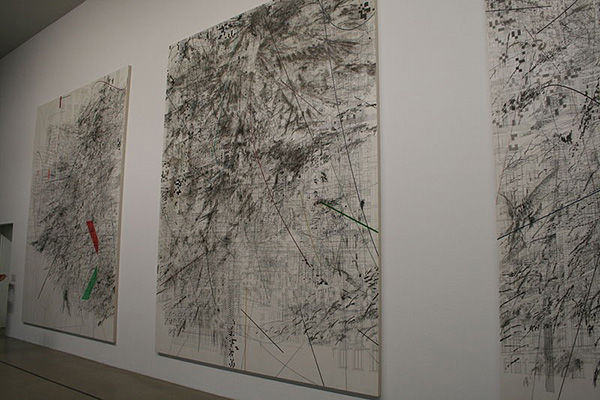
Mogamma (A Painting in Four Parts)
In this series, Mehretu brings together architectural drawings of public spaces where uprisings have occurred, including Tahrir Square in Cairo, Red Square in Moscow, Plaza de la Revolucion in Havana, Assahabah Square in Darnah, and Zuccotti Park in New York City. These images overlap with one another to such an extent that they can only be identified in particular areas of the canvas. On top of these layers of drawing, Mehretu has added brush marks, lines, and shapes inspired by the graphic design of protestors' flags and banners.
In these works, she is exploring public space as a site of political conflict, ceremonial significance, and social charge without necessarily drawing a conclusion. According to Flaunt Magazine, Mehretu uses artmaking as a way of drawing attention to, if not coming to understand "an unconsidered realm that flourishes with the dark matter that lives between individuals and groups, paint and ideas, the canvas and activism." For her, there is a direct link between architecture and politics: "I don't think of architectural language as just a metaphor about space, but about spaces of power, about ideas of power."
The pieces reference political events that are part of Mehretu's personal experience, including the Arab Spring and the Occupy Movement in the United States. She is particularly interested in exploring the contradictions between the expectations and the reality of those events, seen in relation to the spaces in which they occur. The artist notes, "There are historic sites where that type of action has taken place and those sites are ones that are used in the paintings, but also there's this kind of desire and symbolism ... [versus] what really does get achieved, what real social change does happen." This idea is very significant to Mehretu, who sees it as having shaped her upbringing: "I was born in the midst of the utopianist gestures on the continent of Africa ... there was a very different perception of and sense of possibility of what a place could be, but that completely fell apart ... The failure of this optimism composed most of my life."
The title of the series comes from the name of the government building in Tahrir Square in Cairo, "Al-Mogamma," which was a key site of the 2011 revolution in Egypt and the uprisings in the Arab world at that time. The word "Mogamma" also means "collective" in Arabic and has been used to refer to multi-faith spaces. Here, it perhaps references the function of the series as "a memorial to collective sites of communal resistance," as explained by the Tate Galleries.
Ink and acrylic paint on canvas - Various collections
Beloved (Cairo)
Mehretu made this work following a trip to Tahrir Square in Cairo, which was the scene of popular demonstrations in 2011 that saw President Hosni Mubarak (whom she describes as "the most visible dictator of my entire life") step down from power. For the artist, this was a poignant moment of both optimism and uncertainty. The need to process these emotions, brought about by real world events, was her driving inspiration in this work.
In Beloved (Cairo), Mehretu explores the "tension and contradiction" within that historic moment. She depicts the Egyptian city caught in a desert wind, its features stretched out as if pushed and pulled by external forces. The work is neither a map nor an illustration, but an expression of the movement and life of the city that exists in a state of change.
Mehretu's devotion to her subject matter is demonstrated by the level of detail across such a large work (the canvas measures 24 x 10ft), and is reflected by her chosen title. The subject matter is close to her heart as it relates closely to the experiences in her own youth, of the decolonizing of parts of Africa and the Arab/African spring.
She has commented: "I was born in the midst of the utopianist gestures on the continent of Africa ... there was a very different perception of and sense of possibility of what a place could be, but that completely fell apart ... The failure of this optimism composed most of my life, but with the Arab/African Spring, it felt that there were new possibilities."
The artist sees this tension as characteristic of political history, describing it as "this weird entropic cycle of utopian ideals and the impossibility of that ... the moment of imagining what is possible and yet not knowing what that is." Museum director Kathy Halbreich concurs, in saying, "Without being pedantic, or politically naïve, or ideological, [Mehretu's work] deals, I think, with anxiety - the promise and despair we live with now."
Ink and acrylic on canvas - The Broad Museum, Los Angeles
Epigraph, Damascus
This work is made up of architectural drawings of building elements (such as columns and arches) and buildings in Damascus, over which Mehretu has layered additional marks with paint. These sprawl across the canvas in the manner of landscape, albeit not geographically faithful but made up of abstracted elements.
Although the style of Epigraph, Damascus is characteristic of the artist, the result is particularly black and dense. The frantic marks that obscure a large portion of the underdrawing immediately connote chaos, suppresion, and violence. The overall impression is reminiscent of a map or aerial photograph that might be used to chart or demonstrate the effects of war.
The effect of this dense mark making in the upper layers could be to urge the viewer to seek the original drawing underneath, as if looking amongst the ruins of a disaster. This association is fitting in light of the ongoing violent conflict in Damascus that theatens and has already destroyed much of Syria's tangible cultural heritage. Epigraph, Damascus does not depict the city at any particular historic moment but appears to respond to or echo the question of what kind of city might emerge from this war.
The title suggests that this is the artist's summation of Damascus. She perhaps sees this state of flux as characteristic of the city, which has changed architecturally and culturally, in response to conflict, since the 13th century BCE. To an extent, this could be said of any city that is subject to the unpredictability of natural and human diasters. According to author William Kherbek, the combination of controlled architectural drawing and chaotic markmaking in Epigraph, Damascus demonstrates the way in which cities are always destined to depart from the neat visions of urban planners and architects, to reflect unknowns.
Mehretu is particularly interested in uncertainty with respect to political history - "this weird entropic cycle of utopian ideals and the impossibility of that ... the moment of imagining what is possible and yet not knowing what that is." In this sense, Epigraph, Damascus might be understood as showing the city in the midst of a dramatic and violent transformation - its conclusion yet unknown.
Photogravure and aquatint on six panels
Biography of Julie Mehretu
Childhood
Julie Mehretu was born in Addis Ababa, the capital city of Ethiopia, in 1970, the eldest child of her Ethiopian college professor father and American teacher mother.
The family left Ethopia when Mehretu was seven years old, to escape political violence brought about by the Derg's (a military junta) campaign of terror. They settled in East Lansing, Michigan in the United States. Her father taught economic geography at Michigan State University and Mehretu attended East Lansing High School. During high school, Mehretu came out to her friends as gay, though she did not come out to her parents (who responded supportively) until her college years. Mehretu was an excellent student, performing near the top of her class. She recalls feeling immediately comfortable in America, and her childhood has been described as "typically American" from that point on.
Both Mehretu's familial history and her sexuality can be seen as early harbingers of what would inform her later artistic career as displacement and associations to place would become key, overriding themes. She has explained that, "Coming from this African background, you're the children of people who were there during decolonisation, when the world really fundamentally shifted ... Now we're all dislocated ... and there's this constant negotiating of place, space, ideals, ideas." She also states, "I am only the person I am because I was raised in this."
Education and Early Training
Having been interested from a young age in drawing and painting, Mehretu earned her undergraduate degree in art at Kalamazoo College, Michigan. She spent her junior year abroad at Cheikh Anta Diop University in Dakar, Senegal, where she was influenced by local artisans. She returned with a renewed determination to pursue an artistic career.
Describing this journey to the New Yorker's Calvin Tomkins, Mehretu recalls finding her feet following graduation in 1992. She first travelled to San Francisco, a haven for alternative, creative lifestyles. Here she took work as a waitress and began to paint every day, describing her paintings from this period as "the kind of thing you do when you think you're making art, but you're not." While making this work, Mehretu was inspired to continue her art education and was awarded a full scholarship from Rhode Island School of Design (RISD) to study painting and printmaking.
At RISD, Mehretu was drawn to the slow and deliberate process of etching and took this considered approach forward into her drawing and painting. Deeply influenced by her teacher Michael Young, she produced a huge volume of drawings, through which she discovered her distinctive approach to mark making and began to develop a visual language made up of dots, lines, symbols, and shapes. It was at RISD that Mehretu also began to explore aerial views, bringing these areas of marks, which she calls "communities," together in formations that resembled landscapes.
The artist went on to combine this technique with works built up from several layers of drawing and painting; for example, marrying expressive, abstract marks on top of delicate architectural drawing. Working from source material including urban and architectural images, maps, charts, logos, flags, and photographs, together these layers formed "flattened re-imaginings of city life" comprised of multiple points of view. Her practice was further transformed through the use of a computer to digitally manipulate architectural images and project them on to canvas. This technique became particularly important as she began to work at a larger scale, facilitated by access to her own studio as part of a residency program at the Museum of Fine Arts in Houston. The increased intricacy of these works meant that the artist produced just six or seven pieces a year.
Mature Period
Following her graduation from RSID, Mehretu moved back to New York. She set up her studio and began to establish her reputation as a professional painter. In 1999, she showed two of her paintings at Exit Art (a non-profit cultural center) in SoHo and took part in several group shows, including the Museum of Modern Art's "Greater New York" in 2000. As a result, several dealers (both American and international) showed interest in her work, including Christian Haye of the Project gallery in Harlem.
Haye identified Mehretu as an artist who was "taking things in a completely different direction." Her first solo show in 2001 at Project gallery completely sold out before the opening. She has since spoken of such attention as overwhelming, preferring to focus on the work itself and the process of artmaking in the present. In 2005, a collector sued Haye over the right of first refusal on Mehretu's work. The case was the first of its kind and demonstrated the high demand for and high profile of her pieces.
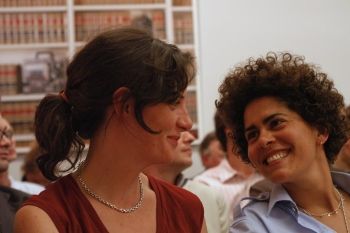
Mehretu has credited her close family and friends for keeping her grounded amongst worldwide success. In 2000, she met the Australian artist Jessica Rankin, with whom she immediately established rapport based on their similar interests. Like Mehretu, Rankin's artwork explored signs, symbols, and mental geographies, using embroidery. Soon after they met, Rankin began showing her work at the same galleries as Mehretu. The synchronistic coupling bloomed, both in love and in their support of each other's artistic careers. Rankin has commented, "We're constantly giving each other feedback and I feel like we see each other's work differently than anyone else does."
A further development in Mehretu's practice came in 2006 during a six-month residency in Berlin. Having become dissatisfied with a paint wash she had applied to one of her pieces, Mehretu began to explore selectively erasing her work in order to reveal the layers of drawing and painting beneath. The Grey Area series of paintings (2007-09), one of which is called Vanescere (disappearance), is built around this idea, and was exhibited at the Guggenheim in New York in 2010. This creative development also inspired Mehretu to accept a commission by Goldman Sachs for their new office building, which she had been going back and forth on due to her heavy workload. The noted location and its public access inspired an eventual commitment from the artist.
Late Period
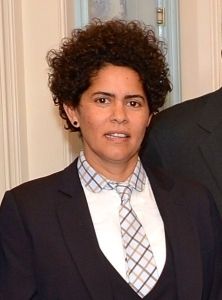
Mehretu married Rankin while still working on the Grey Area paintings and the Goldman Sachs mural. On completing the corporate commission, they hosted a party at Mehretu's studio, to which a large part of the Berlin art community was invited. The couple currently live and work in New York, though they maintain an apartment in Berlin as well. Mehretu has expressed her fondness for the cosmopolitan environment and freedom of Berlin, as well as believing that in Europe, "It's more about what the work is and what the work is doing than who the artist is. That's always, I think, where the conversation should be."
Art critic Jason Farago has remarked on the contrast between Mehretu's chaotic paintings and the calm within her studio, which he describes "as much a think tank as a laboratory," perhaps on account of the large number of reference books it holds. It is important to the artist to remain organized in her working practice, especially now, since she and Rankin have two children: Cade (born in 2005) and Haile (born in 2011). "When you're not a mom you can get up in the middle of the night, paint, sleep all morning ... you can't do that when you have two children!"
This "giving up of control" mentality has infused Mehretu's technique as it has become "freer and messier" as she uses oil and ink on Plexiglas, as opposed to ink on paper, for her monotype prints. She enjoys how these materials promote "a loose, fluid way of working - because nothing is more fluid than oil on Plex." This experience has been liberating for the artist and has reinvented her style.
Mehretu is driven to make her work by real world events and the need to process them: "One of the big issues for me as I continue making paintings is a belief or an insistence that this continues to be necessary, considering what is taking place in the world and how fundamentally messed up it is. ... The new paintings come from this necessary investigative space ... I feel that painting is necessary, essential, and crucial." The feeling has been more pronounced since the political events in Egypt in 2011. Mehretu was heavily influenced by President Hosni Mubarak stepping down from power. Days later, she travelled to Tahrir Square in Cairo, which was the scene of the popular demonstrations that brought this change about. The trip inspired her painting Beloved (Cairo) (2013), in which she explores the "tension and contradiction" within that historic moment.
Mehretu's art is not necessarily inspired by single events or spaces. For example, she has described the process whereby the painting Invisible Line began as a response to the architecture of New York but changed on account of events in Egypt. "I was in here working on New York, and I'm drawing, and this thing is unfolding: I have al-Jazeera on the computer livestream, I'm paying attention to NPR ... So I was looking architecturally at New York, and then suddenly I'm back in Africa." While Mehretu acknowledges the original subject matter brings with it a range of urban experience - "The characters in my maps plotted, journeyed, evolved, and built civilizations. I charted, analyzed, and mapped their experience and development: their cities, their suburbs, their conflicts, and their wars" - the results no longer represent a specific time or place but "an intangible no-place: a blank terrain, an abstracted map space." In this way, Mehretu's work gives new life to her source material. The artist challenges narrow geographic and cultural readings of urban and architectural images by bringing them into a new time and place in the art world.
Inspired by the masses of lines and shapes in Mehretu's work that perhaps suggest networks of urban movement or communication, Farago comments, "Mehretu's paintings come closer than any other artist's today to conveying the world we now live in: culturally hybrid and in constant motion, a synthesis of skyscrapers and ruins." This idea of the pace and change of city life contrasts interestingly with Mehretu's working practice, which is extremely slow. It is not unusual for her to spend a year on a painting, though her drawings are often created more quickly. (Those of a smaller scale are often made in between paintings). Many works take several weeks to dry. Similarly, Mehretu's artworks take a long time to view and digest. She affirms that "All art chooses its own audience ... Certain paintings are made to be consumed fast. But some require a slowed-down time."
The Legacy of Julie Mehretu
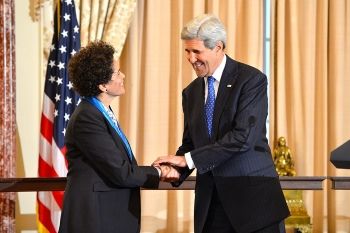
Mehretu's contemporaries at graduate school were figurative artists such as Kara Walker and Shahzia Sikander. As art critic Calvin Tomkins notes, Mehretu presented something different with her approach that combines architectural drawing, maps, symbols, and abstract shapes. Although the works - or elements of them - are inspired by specific events and places such as demonstrations in Tahrir Square in Cairo, wildfires in California, and the Grenfell Tower disaster in London, Mehretu combines these particular histories and geographies with her own thoughts and experiences to create what she calls "story maps of no location." Museum director Kathy Halbreich has praised the work for introducing a new kind of abstraction that is "very much of its time."
One influence on her subject matter is her father's work as a geographer. In her words, Mehretu had "a subconscious awareness of his way of dissecting the world, to try to make sense of it." Stylistically, critics have identified the influence of such 20th century art movements as Futurism, Constructivism, and Abstract Expressionism, owing to her work's dynamism and scale. Mehretu herself is keen to point out influences that are often excluded from the canon, for example, Ice Age carving and Chinese painting. With respect to Abstract Expressionism she cites Helen Frankenthaler and Elaine de Kooning alongside better-known artists such as Jackson Pollock, Willem de Kooning, and Barnett Newman, noting that women and artists of color are rarely "considered part of the story."
Whilst Mehretu's art is inspired by events taking place in Africa and the Middle East, she resists interpretations of her work that fail to see past her ethnicity. According to the artist, her work is not all about "blackness" or "otherness." She believes that there is a failure to "simply accept and understand that a woman of African descent is making large, abstract paintings" and that this is a restrictive view of what artists of color can achieve.
As a person, Tomkins has described Mehretu as "bursting with energy, adventurous and outspoken," while journalist Julie Cerullo calls her "modest and self aware." Art critic Jason Farago notes that she has become one of the most significant painters of her generation, while avoiding "the art world's exhausting social games." This is something that is important to Mehretu and part of her successful relationship with dealer Christian Haye, who managed her publicity to such an extent that she "could just focus on the work, and not pay attention to the noise." Whilst Mehretu is best known in the USA, she has exhibited internationally. Her first solo exhibition in the UK was in 2019, in which she showed smaller scale prints and drawings as opposed to monumental paintings.
Alongside her passion for drawing and painting, Mehretu is interested in music. "When I'm working I am usually listening to music, and I have always been interested in the juxtaposition of looking at images and listening." Her paintings, in the way that they are articulated with dense and less dense moments, have been compared to musical scores. Reflecting this dual interest, Mehretu painted Auguries in 2010, which responds to the first of Wagner's Ring cycle of operas. In the same year, musician Jochen Neurath composed a piece to celebrate the completion of Mural for Goldman Sachs, later performing another for the exhibition of Grey Area. More recently, in 2017, the artist has collaborated with composer and pianist Jason Moran to create music which, in the same way as her painting, explores complex geographies and histories.
Influences and Connections

- Michael Young
- Lawrence Chua
- Beth Stryker
- Tacita Dean
-
![Futurism]() Futurism
Futurism -
![Constructivism]() Constructivism
Constructivism -
![Abstract Expressionism]() Abstract Expressionism
Abstract Expressionism - Chinese painting
- Jessica Rankin
- Jessica Rankin
- Tacita Dean
- Jochen Neurath
- Jason Moran
- Contemporary Abstraction
 Ask The Art Story AI
Ask The Art Story AI